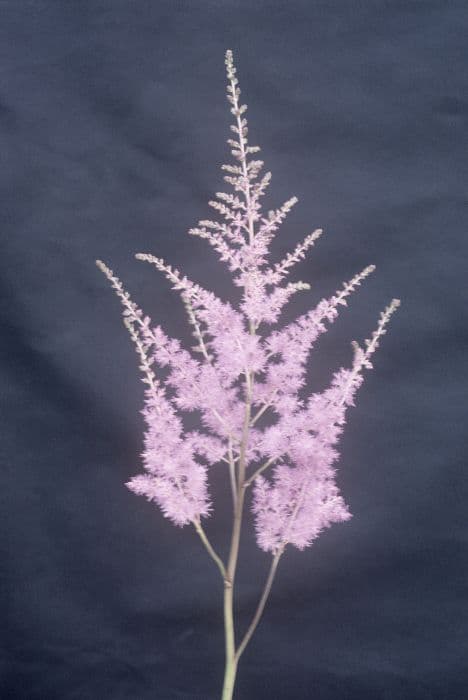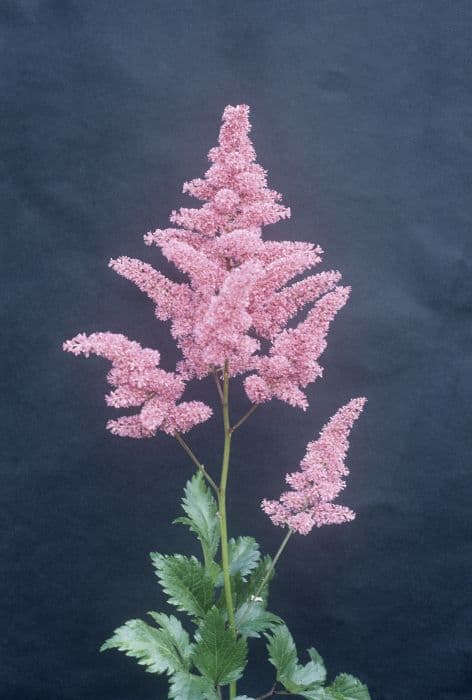Bergenia Bergenia 'Red Beauty'

ABOUT
Bergenia 'Red Beauty' is a perennial plant known for its striking foliage and flowers. The leaves are large, glossy, and leathery in appearance, often taking on a rounded heart shape. They boast a rich, dark green color that can turn to shades of bronze and red during the colder months, adding year-round interest to gardens. The flowers of the 'Red Beauty' are showy and appear in clusters on top of sturdy stems that rise above the foliage. These blooms are typically a vibrant, deep pink to red hue, attracting attention and pollinators alike. The blossoming period brings a delightful contrast between the vivid flowers and the dark leaves, creating a visual spectacle in any garden setting. Overall, the 'Red Beauty' presents a lush and robust appearance with its bold leaves and colorful flowers, making it a favored choice for gardeners looking to add a touch of elegance and color to their landscapes.
About this plant
 Names
NamesFamily
Saxifragaceae.
Synonyms
Red Beauty Bergenia, Pigsqueak, Elephant's Ears, Heart-leaved Bergenia.
Common names
Bergenia cordifolia 'Red Beauty', Bergenia crassifolia 'Red Beauty'.
 Toxicity
ToxicityTo humans
Bergenia 'Red Beauty', commonly known as Elephant's Ears, is not known to be highly toxic to humans. However, like many plants, it may cause minor irritations or allergic reactions in some individuals if ingested or if the sap comes in contact with skin. If ingested, symptoms are typically mild and can include gastrointestinal upset such as nausea, vomiting, or diarrhea. In case of ingestion, it is generally advised to consult a medical professional, especially if the individual is experiencing significant discomfort or persistent symptoms.
To pets
Elephant's Ears is not listed as a highly toxic plant to pets. However, as with humans, it can potentially cause mild gastrointestinal upset if ingested by pets. Symptoms in animals might include drooling, vomiting, or diarrhea. While these symptoms are generally not severe, it is still recommended to keep an eye on your pet and contact a veterinarian if you observe these signs or if your pet has consumed a large quantity of the plant.
 Characteristics
CharacteristicsLife cycle
Perennials
Foliage type
Evergreen
Color of leaves
Varies
Flower color
Pink
Height
1 foot 6 inches (45.72 centimeters)
Spread
1 foot 6 inches (45.72 centimeters)
Plant type
Herb
Hardiness zones
4
Native area
Asia
Benefits
 General Benefits
General Benefits- Attractive foliage: Bergenia 'Red Beauty' has large, glossy leaves that are visually appealing throughout the year.
- Seasonal Interest: The plant offers year-round interest with its evergreen leaves and seasonal flowers.
- Drought tolerance: Once established, it has good resistance to drought, requiring less watering and maintenance.
- Cold hardy: It can survive in cold temperatures, making it suitable for gardens in cooler climates.
- Shade tolerance: This variety can thrive in partial shade, offering flexibility for gardeners with shaded areas.
- Easy to grow: It is known for being low maintenance and easy to care for, which is ideal for novice gardeners.
- Showy blooms: Produces clusters of eye-catching red flowers that can add a splash of color to gardens in the spring.
- Ground cover: Its dense growth habit makes it an excellent ground cover, helping to suppress weeds.
- Attracts wildlife: The flowers can attract pollinators like bees, adding biodiversity to the garden.
 Medical Properties
Medical Properties- This plant is not used for medical purposes.
 Air-purifying Qualities
Air-purifying QualitiesThis plant is not specifically known for air purifying qualities.
 Other Uses
Other Uses- Bergenia 'Red Beauty' leaves can be used for dyeing textiles, as they contain tannins which produce subtle shades of color.
- The large, leathery leaves are sometimes employed in arrangements or as a natural foil to showcase smaller, delicate flowers in floral designs.
- In colder regions, the evergreen foliage can provide winter interest in otherwise barren gardens, creating a lush appearance year-round.
- The thick leaves can be used as natural "cups" or "dishes" in outdoor events, adding a unique, rustic touch to the presentation of certain foods.
- During the Victorian era, plants such as Bergenia were often pressed and used in botanical art, its broad leaves making it a suitable candidate for such practices.
- Photographers may use the plant's vivid flowers as a background for insect and macro photography, taking advantage of its rich colors in spring.
- Creative gardeners might employ the sturdy leaves as stencils for garden path designs or to imprint patterns into mud or soft ground materials.
- In some cultures, the leaves of Bergenia might have been used to create temporary shelter for small animals or as a protective layer over fragile plants in harsh weather.
- The plant can be planted near noisy areas, as its dense growth can help to absorb some sound, making it useful for urban gardens to reduce ambient noise.
- Its robust nature makes it a candidate for exploring plant-based bio-fabrics and sustainable materials in eco-friendly fashion and textile design.
Interesting Facts
 Feng Shui
Feng ShuiThe Bergenia is not used in Feng Shui practice.
 Zodiac Sign Compitability
Zodiac Sign CompitabilityThe Bergenia is not used in astrology practice.
 Plant Symbolism
Plant Symbolism- Endurance: Bergenia plants, with their robust nature and ability to survive harsh conditions, symbolize endurance and the ability to thrive through challenges.
- Protection: The thick, leathery leaves of the Bergenia are reminiscent of a protective barrier, hence the plant is often associated with safety and shelter.
- Adaptability: As Bergenias can adapt to various environments, they are often linked with flexibility and the ability to adjust to different situations in life.
- Transformation: The 'Red Beauty' variety, with its red foliage that changes throughout the seasons, can represent change and transformation.
 Water
WaterElephant's Ears should be watered thoroughly when the top inch of soil feels dry to the touch. This typically translates to once a week, but the frequency may vary based on temperature and humidity levels. It is best to use room temperature water and apply it directly to the base of the plant, avoiding getting water on the leaves to prevent fungal diseases. For an average-sized plant, this means using about 16 ounces of water each time. During the winter months, water less frequently to match the plant's slower growth rate.
 Light
LightElephant's Ears prefer a spot with partial shade to full sun. The ideal location offers morning sunlight and protection from the intense afternoon sun, especially in hotter climates. This ensures that the plant receives adequate light without experiencing leaf burn, which can be a risk in full sun conditions during peak summer months.
 Temperature
TemperatureElephant's Ears thrive in temperatures ranging between 50°F and 75°F, making them suitable for most temperate climates. They can survive minimum temperatures down to 20°F, although they will need protection from frost. The ideal temperature for optimal growth is a consistent range from the upper 50°F to the mid 70°F.
 Pruning
PruningElephant's Ears benefit from pruning to remove spent blooms and damaged leaves, which encourages new growth and improves the plant's overall health. The best time for pruning is in late winter or early spring before new growth starts. Pruning should be done as needed throughout the growing season to maintain the plant's shape and remove any dead foliage.
 Cleaning
CleaningAs needed
 Soil
SoilElephant's Ears 'Red Beauty' thrives in a soil mix that is well-draining, rich in organic matter, and has a slightly acidic to neutral pH of 5.5 to 7. A mix of garden soil, peat moss, and perlite or sand works well to provide the necessary drainage and nutrient content.
 Repotting
RepottingElephant's Ears 'Red Beauty' should be repotted every 2 to 3 years, or when it outgrows its current pot. The best time to repot is in spring before the new growth starts.
 Humidity & Misting
Humidity & MistingElephant's Ears 'Red Beauty' prefers moderate humidity levels but is quite adaptable and can tolerate the lower humidity typically found in homes. No specific humidity level is required.
 Suitable locations
Suitable locationsIndoor
Place in bright, indirect light and keep soil moist.
Outdoor
Plant in partial shade; shelter from harsh sun.
Hardiness zone
3-8 USDA.
 Life cycle
Life cycleBergenia 'Red Beauty', also known as Heartleaf Bergenia, begins its life cycle as a seed, germinating in the spring after experiencing a period of cold stratification that breaks its dormancy. The seedling develops into a rosette of glossy, heart-shaped leaves that grow close to the ground. As the plant matures, it forms a dense, evergreen clump of tough, leathery foliage that persists through the seasons. In early to mid-spring, the plant sends up thick flowering stalks topped with clusters of deep pink to red flowers, attracting pollinators such as bees. After pollination, the flowers fade and form capsules containing seeds that are eventually dispersed to begin the next generation. During the winter season, the foliage may take on a bronze hue, but it remains evergreen until the cycle begins anew with spring growth.
 Propogation
PropogationPropogation time
Spring-Early Summer
Propogation: Bergenia 'Red Beauty', commonly known as Bergenia, is best propagated through division. This process involves separating the plant's rhizomes, which are the underground stems from which the leaves and flowers grow. Propagation time is optimal in early spring or fall after flowering has finished when the plant is dormant or growing slowly. To propagate by division, carefully dig up the plant ensuring you have plenty of roots with each clump. Gently tease the roots apart and cut through any tough rhizomes with a sharp knife or spade, ensuring each division has at least one growth bud. Divisions can be immediately replanted in well-preparing soil, watered thoroughly, and maintained until they establish in their new location.









